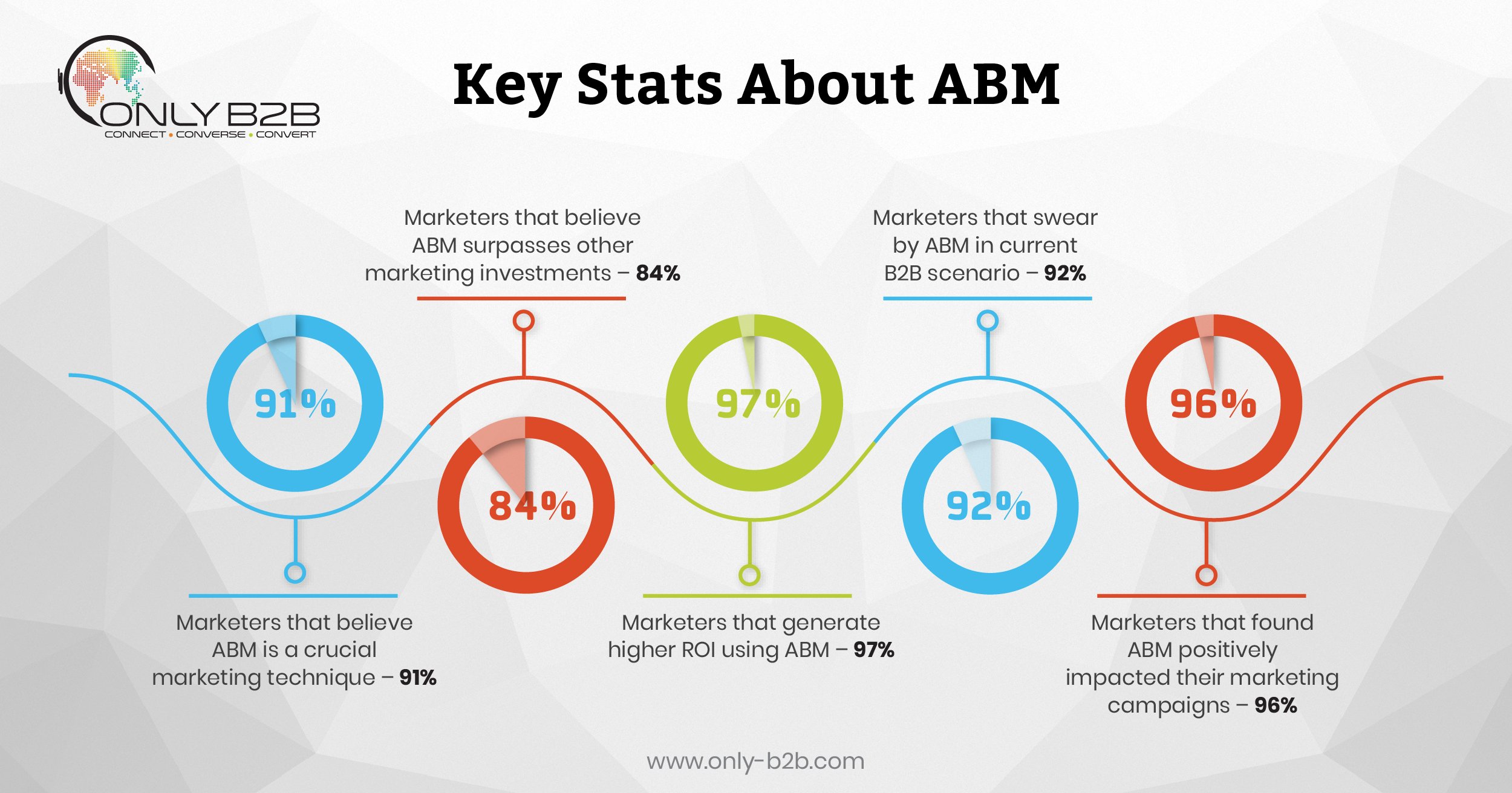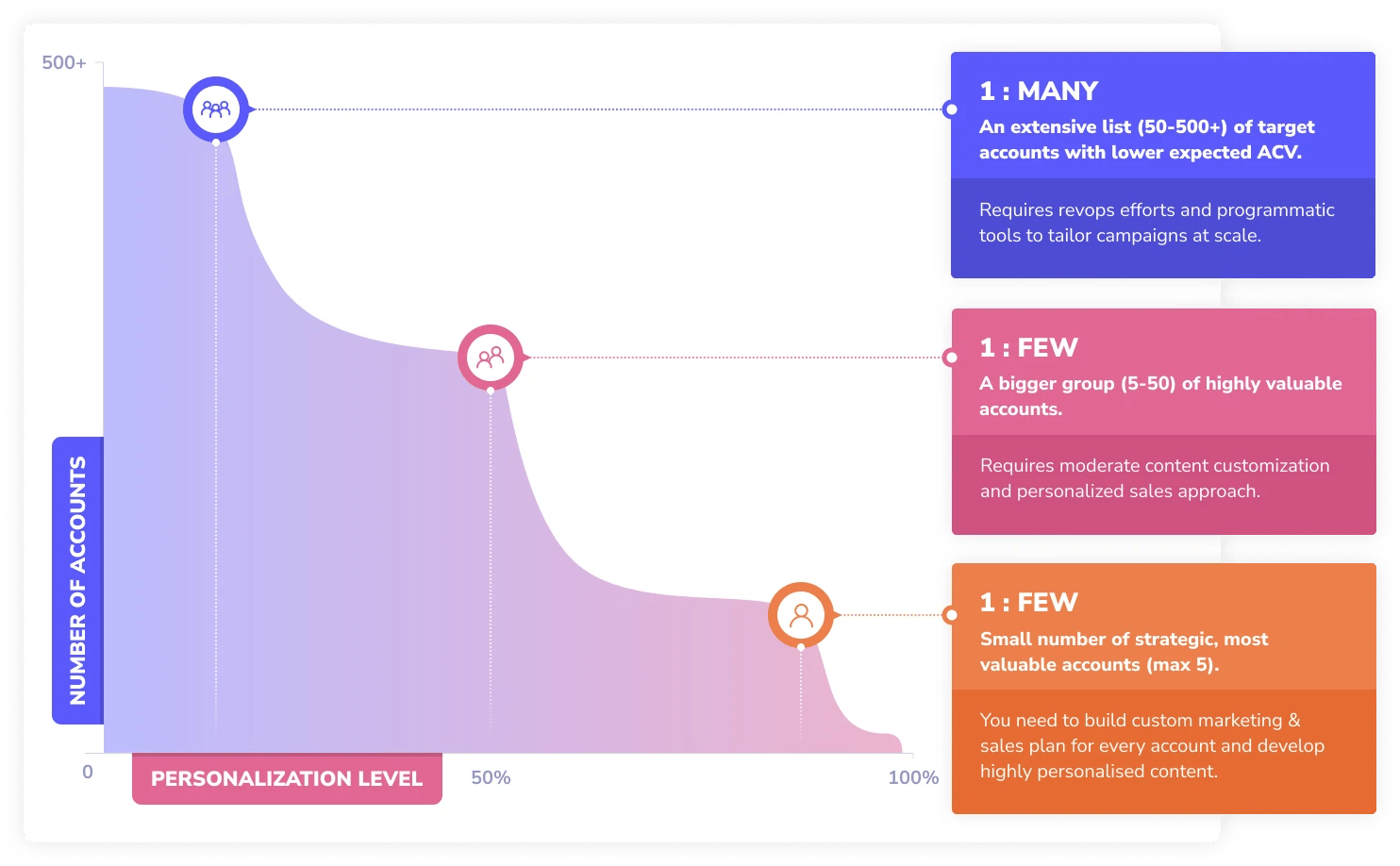
Markus Stahlberg
~2 min
Main Principles And Objectives Of Account-Based Marketing
Account-based marketing (ABM) is a hot topic in the world of digital marketing. The last couple of years have seen an incredible increase in popularity, with the 2020 State of ABM report stating that an impressive 94.2% of respondents now actively use ABM strategies.
This is a significant increase from 2015 when only 20% of B2B marketers took this approach. Popularity accelerated in 2016 when 20% jumped up to 70%. Since then, account-based marketing usage has continued to rise as marketers are getting better and more robust results with this marketing method.

Source: only-b2b.com
As of 2022, 87% of account-based marketers say that ABM initiatives outperform other marketing investments.
This article explores the basic principles of account-based marketing and the three different approaches you can take towards this type of marketing. Let’s dive in.
What are the basic principles of account-based marketing?
There are three main principles of account-based marketing.
- Firstly, ABM is focused on client centricity and insight; it works by solving the buyer’s problem.
- Secondly, the accounts are targeted with tailored campaigns using account insight to drive interest and engagement.
- Thirdly, the complete strategy relies on the collaboration between the sales and marketing teams. This ensures that the accounts are high-value and that the strategy is consistent and effective at all stages of the buyer’s journey.
Account-based marketing is based on the concept that each individual account is treated as a market or industry in its own right. It focuses on reputation and relationship that offers lifetime value, rather than just short-term revenue goals.
What is the ABM strategy?
Account-based marketing takes a different approach to most other marketing strategies. It is not about trying to attract many in the hope that one or two will stick; instead, it is about putting your energy, time, focus, and resources into carefully selected high-value accounts that are likely to convert.
To some, it may seem strange to limit your audience in this way intentionally. However, these accounts are considered incredibly high-value as they are your absolute ideal clients and are likely to convert and become loyal customers.
When your time, energy, and resources focus on a few carefully selected accounts rather than an entire market or industry, you become much more efficient with your marketing efforts. You are directly communicating with your ideal client, having identified the key stakeholders and how you can solve their challenges.
These accounts are identified through extensive research. They have been carefully selected through a joint effort by both the marketing and sales teams. This means that the accounts really epitomise your absolute ideal customers.
The alignment between the sales and marketing teams makes for the ultimate power team, resulting in an effective strategy and higher revenues in a shorter time frame.
In a nutshell, an account-based marketing strategy consists of identifying the key accounts, locating the key stakeholder, and targeting them with bespoke, tailored content to engage, delight, and ultimately convert them into loyal customers.
What are the types of ABM?
There are three account-based marketing approaches, one-to-one, one-to-few and one-to-many. Each takes a slightly different approach to account-based marketing, but they all still uphold the basic principles of account-based marketing.
These three different types came about in response to the growing demand for ABM strategy. The increased popularity in account-based marketing and the recognition that lead generation and nurturing are more effective when targetted at high-value specific accounts has meant that marketers have implemented three different types of ABM.
Utilising these different approaches and assessing which one is the most effective for you and your accounts enables faster expansion and broader coverage. Each method is slightly different, and depending on your goals, objectives, and resources; one might be more suitable than another. Your account-based marketing team can decide which approach is most appropriate for their needs.

Let’s explore each of these types of account-based marketing in more detail.
One-to-one ABM
One-to-one account-based marketing is the original approach to ABM. It is not uncommon for one marketer to run several of the accounts, in fact, on average, a full-time account-based marketer will manage four accounts.
How does it work?
One-to-one account-based marketing requires the most investment but also has the highest return on investment. The accounts teams and sales team will conduct in-depth research to identify the perfect target accounts.
Once selected, they will work in alignment to produce individualised, tailored content that speaks directly to the account. They build solid relationships with these carefully chosen accounts and demonstrate an in-depth understanding of their issues, challenges, and pain points.
One-to-one account-based marketing is often favoured by companies that already have a database of existing customers or clients. Typically this approach targets predominantly existing accounts with a smaller proportion of new accounts.
One-to-one ABM objectives
One-to-one account-based marketing is focused on:
- Changing perceptions
- Account engagement
- Building relationships
- Identifying opportunities
- Converting into sales
This approach to account-based marketing directly impacts your business outcomes, such as revenue, growth, advocacy, and client lifetime value.
One-to-one ABM tactics
Some of the most effective account-based marketing tactics include:
- One-to-one meetings
- Account-specific thought leadership
- Private events
- Executive engagement plans
- Innovation days
One-to-one ABM Success metrics
The success metric for this ABM approach goes beyond revenue, although revenue results are significant. Brand perception, relationship, business collaboration, client advocacy, and loyalty are all key metrics to measure.
One-to-few ABM
One-to-few account-based marketing means that the marketing and sales teams will partner to identify and focus on clusters of accounts. These clusters usually consist of 5 to 15 accounts each.
Typically, one-to-few ABM is for accounts considered second-tier that are not considered your absolute highest value accounts. It is not uncommon for companies to start with this account-based marketing approach before transitioning to one-to-one ABM.
How does it work?
One-to-few account-based marketing takes a slightly different approach to the other two types of ABM. As the accounts are split into separate clusters rather than approached directly, they need to be arranged differently.
These clusters are organised by specific similar attributes. For example, they might have similar pain points that they are trying to work through, or they might have the same initiatives. The accounts are then put into these clusters, with approximately 5 to 15 in each.
As with all ABM, the collaboration with the sales team is critical and is focused on making the key decisions, such as deciding which accounts to target, which issues to highlight and how you resolve them.
With a one-to-few ABM strategy, you can tailor existing content to retarget multiple accounts. This approach covers more accounts without relying on new marketing resources. The content is created to reflect how the accounts have been divided. For example, if your account list is grouped into pain points, all accounts with the same pain point will receive that content.
Typically the content used to approach these accounts is lightly customised and often repurposed. This means that there is less investment. However, this is reflected in the ROI, especially compared to one-to-one ABM.
One-to-few ABM objectives
The objectives of this approach to account-based marketing are to:
- Build relationships
- Increase account engagement
- Identify opportunities
- Generate leads
As we said above, it is not uncommon to start with this approach before transitioning into one-to-one ABM when you are confident that your target accounts are high-value and offer high ROI.
One-to-few ABM tactics
Some of the most effective tactics include:
- One-to-one meetings
- Email marketing
- Customer collateral
- Executive engagement
- Reverse IP tracking
One-to-few ABM success metrics
Key success metrics for a one-to-few ABM strategy include pipeline and life value potential as well as revenue growth. Marketers use this type of account-based marketing to target both existing accounts and new accounts.
One-to-many ABM
One-to-many ABM is the newest of the account-based marketing approaches. It is based on a one-to-many model in which one marketer will manage hundreds of accounts.
How does it work?
This approach has much more comprehensive coverage than the previous two and is less resource-intensive. However, this approach does also have the lowest ROI. It is the opportunity to reach many, but you can’t guarantee results in the way you can with a one-to-one ABM strategy.
One-to-many ABM typically targets segments, such as horizontal or vertical markets. A horizontal market is when your product or service meets the needs of a wide range of buyers across different sectors. In contrast, a vertical market is when your product or service is targeted to a group of customers with a specific need. With this in mind, it is easy to see why taking this approach is not considered as direct as the other two types of account-based marketing.
Unlike one-to-one and one-to-few ABM, the content used to engage with the accounts is less customised and individualised. Instead, it tends to be repurposed. Properly curated content can still be effective, though. Typically outbound and inbound marketing tactics are utilised to reach the high volume of accounts.
One-to-many ABM leverages technology. It uses it for targeting, analytics, and personalisation across hundreds of accounts. It uses social listening to direct content to leads that have been generated through reverse IP tracking and cookies.
One-to-many ABM objectives
The objective of this approach is to generate leads. Once the leads have been generated, they can be targeted more directly using other ABM approaches.
One-to-many ABM tactics
This approach uses outbound tactics to reach accounts. Some examples include:
- Direct mail
- Email blasts
- Media advertising
It will then adopt inbound marketing tactics to filter leads and to nurture the target accounts. This approach enables you to collect customer insight to support up-selling, cross-selling, and renewals. Some of the most common tactics for one-to-many ABM include:
- Email marketing strategy
- Reverse IP tracking
- Direct mail
- Social media
- Blog outreach
One-to-many ABM success metric
Key success metrics include customer life value potential and lead generation. You can also measure revenue growth to see if this is an effective ABM method for your business.
How to align sales and marketing
If there is one thing you may have noticed throughout every type of account-based marketing approach, it is the alignment of the sales and marketing teams and how this supercharges your marketing efforts.
This collaboration is the secret sauce of account-based marketing. It is the reason that it is so effective. It might seem obvious that these teams work closely together. However, it is easily forgotten in the hustle and bustle of putting strategies and campaigns into action.
The sales and marketing alignment starts right at the beginning of your account-based marketing strategy before you even start building your target account list.
There needs to be solid communication between both departments so that all members are clear on their part within the account-based marketing strategy. This clear communication and understanding of the ultimate goal ensure that the marketing and sales are in sync. You can be confident that you have the most suitable target account list and that your strategy for reaching, engaging, and delighting them is top-notch.
While the overall objective may be to land new accounts or upsell your existing accounts, the marketing and sales team needs smaller targets that reflect their collaboration. The sales and marketing alignment can make all the difference to an account-based marketing campaign.
So there we have it. The basic principles of account-based marketing are to keep the client and target account at the core of your strategy and target them with tailored marketing campaigns that utilise personalised content.
To make sure that you are approaching the best possible target accounts, and optimally engaging with them, the sales and marketing efforts need to be working in alignment to ensure the best ROI.
We have explored the three different approaches to account-based marketing and how they each work towards slightly different goals and objectives. Nevertheless, they are all effective marketing strategies that engage and delight your target accounts to convert them into loyal customers.